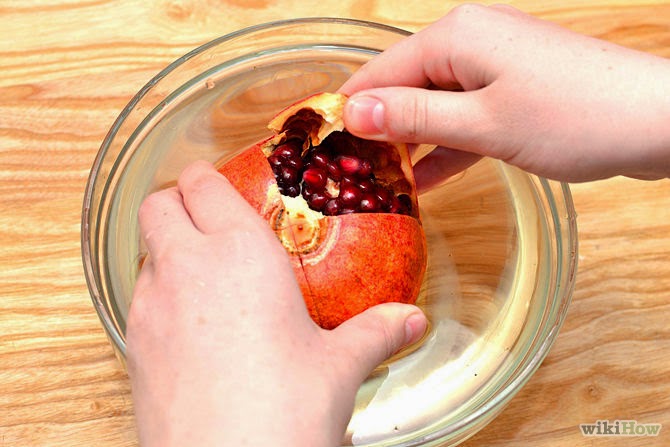ANDALUCÍA: You will have seen them in the shops, this is their season. Different sizes but all about the same colour. What you may not know is that in Spanish, the fruit is called a granada -- yes, the same name of a whole province in Andalucía, as well as one of the liveliest cities in Spain and, of course, home to the Alhambra. It was considered a great delicacy during Roman times, and later, especially by the Moors, who lived in the area for almost 800 years, until 1492. After all, it contains phosphorus, potassium, magnesium, sodium, calcium and vitamins A, B and C,. It is excellent for stomach problems such as heartburn, hernia hiatus, reflux, etc. In addition, prevents problems kidney and respiratory (such as asthma), anemia, atherosclerosis and improves combat high levels of uric acid. There are plenty of ways to eat a pomegranate and I've tried most of them:
The first time I opened one up, I simply spooned the seeds out and ate them. Delicious, but not as easy as it seemed. Much experimentation has made me come to the conclusion that the following is the best and easiest way:
Pick a pomegranate that has thin, tough, and unbroken skin. The heavier the pomegranate is, the juicier it will be.
Cut off its crown with a sharp knife
Score the pomegranate with cuts as if you are going to break it into quarters.
Scoop the seeds up which should mostly be floating on the top of the water,
then let dry for 5 minutes.
then let dry for 5 minutes.
Store the seeds if you don't want to eat them right away. You can lay them flat in a container and refrigerate them for up to three days, or freeze them for up to six months. I keep a supply in the fridge and add it to my morning cereal and salads -- it rarely lasts the three days ...
Halloween is over (unnecessary import from the USA!) but if you don't want to waste the shell,
carve it into a jack-o-lantern, pop in a candle and and store it in a cool, dry place until next year!
By the way, granate is the name of a particular kind of red colour in Spain, which seems fair enough, and the tricky-to-get-to juicy part that surrounds the seed and gives it its taste and is the main ingredient in pure grenadine, though colouring is often added to the cheaper brands.
Both the Romans and Moors used the juice to dye the imperial red of their clothing, and it defies calculations to guess how many of these fruits had to be crushed and sifted to obtain a sufficient amount -- they then discovered that those pesky little white flies that plagued the South of Spain a few years ago, and decimated the cacti were better at giving them the colour they wanted, and there were a lot of them about: squish them and you get a tiny red smudge. But that's another story ...











Just remembered: granada is also the word in Spanish for hand grenade ...
ReplyDelete